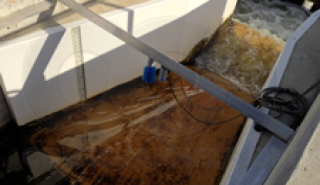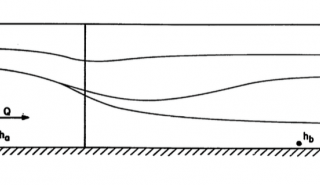 Submergence in a flume is where the downstream conditions are such that they limit or restrict flow out of the flume. It’s important to check for submergence, as limiting the discharge means that the flume will OVER INDICATE the actual flow rate.
Submergence in a flume is where the downstream conditions are such that they limit or restrict flow out of the flume. It’s important to check for submergence, as limiting the discharge means that the flume will OVER INDICATE the actual flow rate.
To determine if a flume is submerged you’ll need to know some basic information:
- Flume type and size
- Submergence transition (St)
- Depth at the primary point of measurement (Ha)
- Depth at the secondary point of measurement (Hb)
Submergence Transition (St)
The submergence transition is the point at which the effects of downstream conditions sufficiently slow and back up flow into the flume such that the INDICATED free flow discharge needs to be corrected.
Submergence transitions differ for each flume style and size.
St values are:
- 50-80% for Parshall flumes
- 85-90% for Palmer-Bowlus flumes
- 25-30% for HS / H / HL flumes
- 75-85% for Trapezoidal flumes
- 60-80% for Cutthroat flumes
- 90% for RBC flumes
Note that neither the HS / H / HL nor the Montana flume are intended for use in submerged flow conditions.
Openchannelflow provide the submergence transition specific to the flume style / size at the top of each flume’s flow table.
Points of Measurement
The primary point of measurement is simply where you take your normal flow reading, while the secondary point of measurement is located in (or downstream of) the throat.
The location of the secondary point of measurement varies by flume style. For Parshall flumes, this is located in the throat of the flume. For Palmer-Bowlus and RBC flumes, it is downstream of the throat ramp. For Cutthroat and Trapezoidal flumes, it is in the discharge section of the flume.
Taking the Level Readings
Once the submergence transition value is known and the points of measurement located, it’s now time to take the actual level readings.
Remember that the same zero elevation is used for both the Ha and Hb levels! For most flumes (other than the Palmer-Bowlus and RBC), the floor of the converging section of the flume is the zero elevation. For Palmer-Bowlus and RBC flumes, the zero elevation is the same as the top the throat ramp.
Calculating the Submergence Ratio
With the Ha and Hb levels in hand, the next step is to calculate the submergence ratio. The ratio is simply the downstream level to the upstream level:

Is the Flume Submerged?
Knowing the actual degree of submergence the flume is experiencing, it is simply to compare it against the submergence transition.

If it is above the submergence transition, then the flume is submerged and the flow must either be corrected, the downstream channel modified, or the flume raised.
While more common at higher flows, it is important to remember that submergence can occur at any flow rate!





